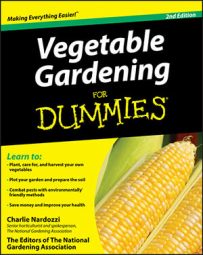For vegetable gardeners, each type of mulch — organic and inorganic — has a unique purpose. No matter which you choose, however, mulching your vegetable garden has multiple rewards: It suppresses weeds, holds in moisture, modifies soil temperature, lessens the chances of certain diseases attacking your plants, and adds an attractive look to your garden.
Organic mulch
Organic mulch includes grass clippings, compost, leaf mold, pine needles, shredded bark, nut shells, cotton gin waste, straw hay, grain and fruit byproducts, composted manure, mushroom compost, peat moss, cocoa hulls, and sawdust. Some of these mulches are easier to find in different parts of the country. You can even use newspaper as an organic mulch; black-and-white newspaper print is perfectly safe to use in your garden, and most colored inks are soybean-based and biodegradable.
Generally, a 2- to 4-inch layer of organic mulch, spread evenly on the ground beneath your plants, is sufficient. However, you may have to replenish the mulch during the growing season, especially in hot summer areas, because many organic mulches break down quickly.
Here are the downsides of some types of organic mulches. As minor as they are, they may lead you to choose one type of organic mulch over another:
Bark mulches, such as pine, are acidic: So if you use them, keep a close eye on the pH level of your soil and correct it accordingly.
Grass clippings decay quickly and must be replenished often: Make sure that lawn clippings you use for mulch haven't been treated with herbicides that can damage or kill vegetables.
Fresh sawdust robs nitrogen from the soil as it breaks down: Add supplemental nitrogen to your vegetables if they grow slowly or start to turn yellow.
Peat moss or leaves can pack down or get hard and crusty: Water may not penetrate these mulchesPeat is also expensive.
Straw or cocoa hulls can blow around in the wind: You may want to avoid them if you live in a windy area.
Organic mulch, which keeps the soil cool, may slow the growth and maturity of warm-season crops such as tomatoes and melons: This cooling can be especially problematic in areas with cool summers. However in very hot-summer areas of the country, organic mulches work to keep the roots of even warm-season crops cool and healthy.
Composted manures may burn young vegetables if used as mulch because the manures vary in the amount of nitrogen they contain: If you want to use composted manure, mix it with three times the volume of another organic mulch before applying it.
Inorganic mulch
Inorganic mulch includes things like plastic, landscape fabric, and believe it or not, old carpet.
The color of plastic mulch you use depends on what you're growing. Some vegetables grow better with certain colored plastics. For example:
Tomatoes, eggplants, and strawberries grow best with red plastic mulch.
Melons grow well with dark green or IRT (infrared transmitting) plastic mulch.
Peppers like a silver-colored mulch.
White plastic is good for hot climates where you want to stop weeds from growing but not heat up the soil.
Black plastic is good for weed control and warming soils. It can be used on many vegetables including cucumbers and squash.
Beside plastics, you also can use the following inorganic mulches in your vegetable garden:
Cardboard: Even though it's biodegradable, cardboard takes so long to decompose that you treat it as an inorganic mulch. You can cut cardboard boxes to fit in pathways. If you don't like their look, cover them with hay or straw.
Landscape fabric: This inorganic mulch doesn't warm the soil as much as black plastic, but it's permeable, enabling you to water through it. It also does a good job of keeping down weeds.
Rug strips: Roll out 3-foot rug strips and place them nap side down, leaving about 6 inches of open soil between strips for irrigation and planting. Even though rug strips look pretty weird in a garden, they keep the weeds down and make a nice path.

